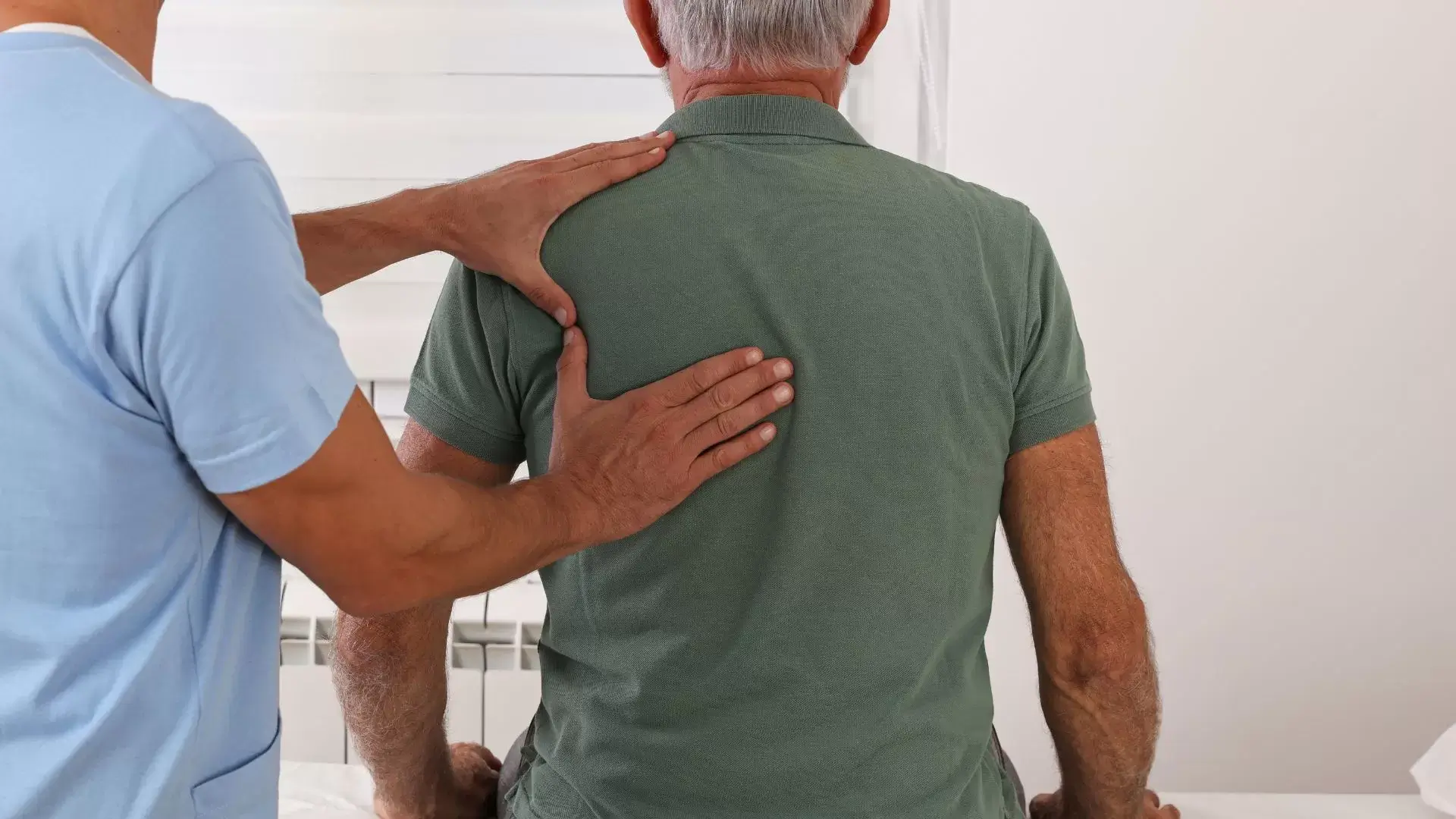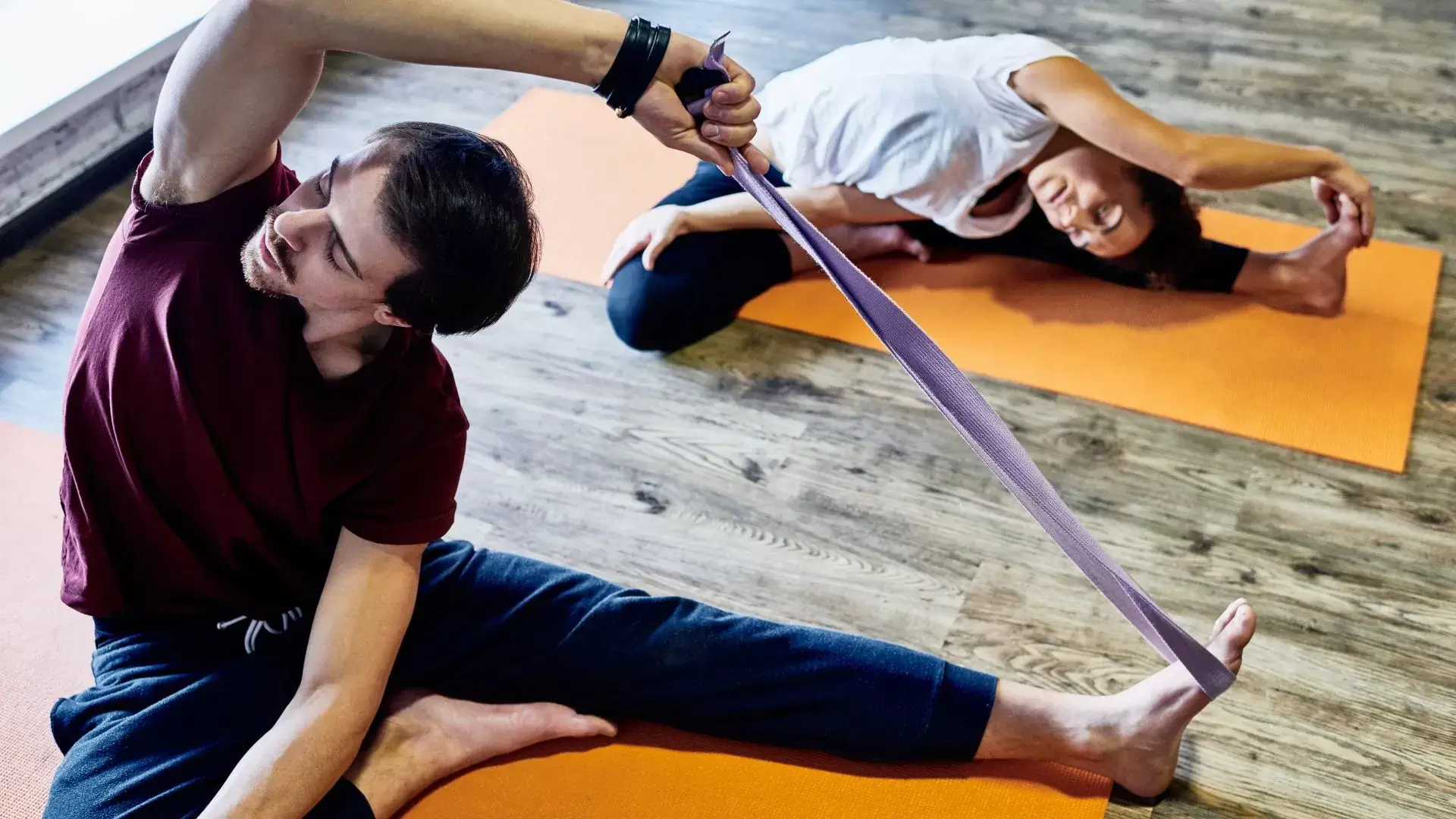We’re here to provide effective physiotherapy for lordosis in Mississauga, focusing on restoring proper spinal alignment and relieving discomfort. Our tailored treatment plans include core strengthening, postural correction, and targeted exercises to address the underlying causes of lordosis. We recognize how important it is to alleviate symptoms like lower back pain and stiffness. Our compassionate team will guide you through personalized rehabilitation strategies, including ergonomic adjustments for daily activities. By addressing these concerns, we can help you achieve long-term spinal health. There’s so much more to discover about our approach and how we can support your journey to wellness.

At Mississauga Physio Chiro Clinic, we offer thorough physiotherapy and chiropractic services designed to effectively address lordosis and enhance overall spinal health. Our approach combines spinal alignment therapy, postural correction, and core strengthening to promote spinal stability and alleviate discomfort associated with poor posture.
During our lordosis treatment, we carefully assess each patient’s individual needs, tailoring our spinal rehabilitation programs to guarantee peak results. We realize that addressing lordosis requires a complete strategy, which is why we incorporate various techniques, including stretching exercises for lordosis, to improve flexibility and reduce tension.
Our dedicated team of professionals in Mississauga is committed to empowering patients with the knowledge and tools needed for long-term spinal health. We emphasize the importance of maintaining proper posture and engaging in core strengthening activities, as these play a crucial role in preventing further issues related to lordosis.
Understanding lordosis requires us to explore its various causes and contributing factors that can lead to this curvature of the spine. Lordosis can manifest in different regions, most commonly as lumbar lordosis in the lower back or cervical lordosis in the neck. One significant factor contributing to this condition is postural misalignment, often resulting from poor spinal posture during daily activities.
Weak core muscles play a critical role in maintaining proper spinal curvature, as they support the spine’s alignment. When these muscles are underdeveloped, it can lead to excessive curvature and discomfort. Additionally, tight hip flexors can further exacerbate this condition by pulling the pelvis forward, creating a muscle imbalance that affects overall spinal flexibility.
Other contributing factors may include sedentary lifestyles, which can lead to decreased spinal flexibility, and repetitive movements that strain the spine. By understanding these causes, we can better address lordosis through targeted physiotherapy interventions, helping to restore balance and improve our overall spinal health. Together, we can work towards enhancing our posture and reducing the impact of lordosis on our daily lives.
Recognizing the signs and symptoms of lordosis is essential for early intervention and effective management of this spinal condition. We need to be aware that excessive lordosis often manifests as an abnormal spine curvature, particularly in the lumbar spine. This can lead to noticeable changes in posture, where the lower back appears overly arched.
Many individuals with lordosis experience lower back pain, which can be attributed to spinal instability and dysfunction. When we assess posture, we should look for signs such as a protruding abdomen or an exaggerated arch in the lower back. Other common lordosis symptoms may include muscle stiffness, discomfort during certain movements, and even fatigue in the lower back muscles.
It’s important to understand that various lordosis causes, including obesity, poor posture, or muscle imbalances, can exacerbate these symptoms. By recognizing these signs early, we can seek appropriate help and initiate corrective measures. It’s crucial that we take action to address any spinal misalignments before they lead to more serious complications. Identifying these symptoms empowers us to improve our spine alignment and overall well-being.
Physiotherapy plays an essential role in managing lordosis by addressing underlying issues, improving posture, and enhancing overall spinal health. For those of us experiencing hyperlordosis, it’s important to understand how our spinal biomechanics can affect our daily lives. Through targeted interventions, we can improve our spinal mobility and alleviate discomfort.
Our physiotherapy approach often includes postural exercises aimed at correcting pelvic tilt and enhancing body awareness. Strengthening exercises for lordosis focus on the muscles that support the spine, combating core instability and promoting better alignment. By incorporating spinal decompression techniques, we can relieve pressure on the discs and improve overall spinal function.
Furthermore, muscle strengthening is crucial for providing the support needed to maintain a healthy posture. We recognize that back pain relief is a primary concern for many of us, and through consistent physiotherapy sessions, we can develop personalized treatment plans that cater to our specific needs. By working together with a qualified physiotherapist, we can effectively manage lordosis and lead a more active, pain-free life.

Evaluating lordosis involves a combination of diagnostic tests and imaging techniques that help us accurately assess spinal curvature and identify any underlying issues contributing to discomfort. We often start with a thorough physical examination, focusing on identifying spinal deviation and vertebral misalignment. This initial assessment can reveal signs of hypolordosis or excessive curvature, allowing us to tailor our approach.
Diagnostic tests, including X-rays and MRI scans, play an important role in visualizing the lumbar and cervical spine. These imaging techniques help us detect spinal compression and assess any spinal joint dysfunction. By analyzing the results, we gain valuable insights into the exact nature of the curvature and its potential impact on overall spinal health.
Incorporating tailored lumbar spine exercises and spinal flexibility exercises into our treatment plan is essential. These exercises not only strengthen the surrounding musculature but also promote improved posture and spinal alignment. By evaluating lordosis thoroughly, we can develop effective strategies that address the unique challenges each patient faces, ultimately guiding them toward a more comfortable and functional life.
To enhance spinal alignment, we must prioritize postural correction therapy, which addresses the habits and movements that contribute to lordosis. Many of us may unknowingly adopt an anterior pelvic tilt, exacerbating our spinal issues. By promoting a posterior pelvic tilt, we can shift our posture towards a more neutral alignment, essential for spinal support and lordosis prevention.
Incorporating ergonomic posture into our daily routines can greatly impact our spinal health. Simple adjustments, like ensuring our workstations are properly set up, can help facilitate better posture. Additionally, chiropractic adjustments and spinal manipulation can provide immediate relief and support our long-term goals.
We should also focus on hamstring stretching and hip flexor stretching, as tight muscles can hinder our ability to maintain proper alignment. Engaging in functional movement patterns during our daily activities is essential, as it helps reinforce the correct postural habits we’re developing.
Together, we can work towards improving our spinal alignment through these therapeutic approaches. As we commit to postural correction therapy, we’ll not only alleviate discomfort but also foster a healthier spine for the future.
Incorporating core strengthening exercises into our routine is essential for enhancing spinal stability and supporting proper alignment, especially for those dealing with lordosis. These exercises help counteract the effects of an exaggerated lumbar curve and swayback posture by targeting the muscles that support our spine.
When we engage in physical therapy for lordosis, we often focus on strengthening our core, which includes the abdominals, obliques, and glutes. Weak glutes and tight lower back muscles can contribute to spinal muscle tension, leading to discomfort and poor posture. By improving our core strength, we provide better lumbar support, which helps alleviate some of the strain on the thoracic spine.
Incorporating targeted core strengthening exercises not only enhances spinal stability but also promotes overall functional movement. We might consider exercises like planks, bridges, and bird-dogs to engage these vital muscle groups effectively. As we progress, we’ll likely notice an improvement in our posture and a reduction in discomfort associated with lordosis. Ultimately, prioritizing these exercises can lead to a more balanced and aligned spine, paving the way for a healthier, more active lifestyle.
Stretching techniques play an essential role in enhancing flexibility and addressing the muscular imbalances associated with lordosis, allowing us to promote better spinal alignment and reduce discomfort. By incorporating these techniques into our physiotherapy routines, we can effectively target tight muscles that contribute to poor posture and spinal misalignment.
Common stretching exercises focus on the hip flexors, hamstrings, and lower back to alleviate the tension that can exacerbate lordosis. Additionally, incorporating cervical spine exercises is crucial for maintaining proper alignment in the neck, which can also be affected by lordosis. These exercises not only aid in posture correction but also help in managing conditions like facet joint dysfunction and degenerative disc disease.
As we engage in these stretching techniques, we must be mindful of our limits to avoid strain, especially if we’re dealing with spinal arthritis or other underlying conditions. Consistency in practice will yield improved flexibility and contribute to overall spinal health. By working together with our physiotherapists, we can develop a personalized stretching regimen that addresses our specific needs, ensuring we achieve the best possible outcomes for our lordosis management.

Manual therapy and spinal mobilization techniques can greatly alleviate pain and improve function for individuals dealing with lordosis, fostering a sense of relief and promoting better spinal alignment. In our practice, we often utilize these methods to target specific areas of discomfort within the vertebral column. By applying manual therapy, we can address issues such as spinal nerve impingement and nerve compression, which frequently contribute to neck pain and discomfort.
Spinal mobilization helps us gently restore proper movement within the spine, facilitating improved mobility and reducing pain. These techniques not only assist in spine correction but also help in enhancing overall posture. During our sessions, we conduct a thorough gait analysis to identify any compensations or imbalances that may arise from lordosis.
As we work together, we focus on relieving tension in the surrounding muscles, allowing for better alignment and function. Our goal is to guarantee that each individual experiences significant pain relief, ultimately leading to a more active and fulfilling lifestyle. Through consistent physiotherapy for lordosis, patients often find themselves on a path toward long-term improvement and well-being.
Correcting pelvic tilt is vital for improving posture and spine health, as it directly influences the alignment of the entire musculoskeletal system. At our clinic located at 1834 Lakeshore Rd W unit 6C, Mississauga, ON L5J 1J7, we recognize how conditions like scoliosis, kyphosis, and spinal stenosis can lead to vertebral compression and discomfort.
When the pelvis tilts excessively forward or backward, it can create a ripple effect, affecting the spine’s alignment and overall posture. This misalignment may contribute to chronic pain and hinder mobility. Through targeted physiotherapy techniques, we can help restore balance to the pelvis, which is essential for achieving ideal spinal health.
We focus on individualized assessments and treatment plans that include strengthening and stretching exercises designed to address specific imbalances. By correcting pelvic tilt, we can alleviate undue stress on the spine and surrounding structures, ultimately promoting better posture and reducing the risk of further complications.
If you’re experiencing issues related to pelvic tilt, don’t hesitate to contact us. Together, we can work towards improving your spinal health and overall quality of life.
At our clinic, we recognize that analyzing functional movement and gait is essential for enhancing mobility and overall quality of life. By evaluating how we move, we can identify patterns and imbalances that may contribute to discomfort or limitations, especially in individuals with lordosis.
During our evaluations, we focus on various aspects of movement, including how we walk, run, or perform daily activities. This detailed analysis allows us to pinpoint specific areas that require attention, such as muscle weakness, joint stiffness, or improper mechanics. Understanding these elements helps us develop tailored treatment plans that address each individual’s unique needs.
Incorporating functional movement and gait analysis into our physiotherapy regimen not only aids in rehabilitation but also empowers us to prevent further complications. By improving our movement patterns, we can enhance our overall strength, coordination, and balance, leading to better mobility.
Through dedicated sessions, we can work together to refine our movements, ultimately fostering a more active and fulfilling lifestyle. We’re committed to guiding you on this journey, ensuring you regain confidence in your mobility and enjoy life to its fullest.
Making ergonomic adjustments in our daily environments is crucial for maintaining proper posture and alleviating the discomfort often associated with lordosis. By creating a workspace that supports our bodies, we can greatly reduce strain on our spines.
First, let’s verify our chairs provide adequate lumbar support. Ideally, the backrest should support the natural curve of our lower back. We should also adjust our desk height so our elbows are at a 90-degree angle while typing. When it comes to our computer monitor, it should be at eye level, allowing us to keep our neck in a neutral position.
We can also benefit from using footrests if our feet don’t comfortably reach the ground. Additionally, incorporating regular movement into our routines is crucial; standing up to stretch or walk briefly every hour can help maintain flexibility and reduce stiffness.
Addressing chronic back and neck pain associated with lordosis requires a multifaceted approach that combines targeted exercises, posture awareness, and professional guidance. We recognize how debilitating this pain can be, impacting our daily activities and overall quality of life. By focusing on specific exercises that strengthen the core and back muscles, we can help alleviate discomfort and improve spinal alignment.
Incorporating stretches into our routine is equally important. These can enhance flexibility and reduce tension in the muscles supporting our spine. We should also pay attention to our posture throughout the day, as maintaining proper alignment can greatly reduce strain on our back and neck.
Working with a physiotherapist can provide us with personalized strategies tailored to our unique needs and conditions. They can guide us through safe, effective exercises and monitor our progress, ensuring we’re on the right track.
It’s essential to remember that we’re not alone in this journey. Support from healthcare professionals and loved ones plays a crucial role in managing pain and promoting recovery. Together, we can take proactive steps toward a healthier, pain-free future.
To effectively manage and prevent the progression of lordosis, we must focus on building strength and mobility in key muscle groups that support proper spinal alignment. Strengthening our core, glutes, and back muscles can help stabilize the spine and reduce excessive curvature. We’ll incorporate exercises like planks, bridges, and back extensions into our routine, which not only enhance muscle strength but also promote better posture.
In addition to strength, improving our flexibility is essential. Tight hip flexors and hamstrings can exacerbate lordosis, so we should include stretching exercises such as lunges and hamstring stretches. These will help lengthen those tight muscles and allow for a more balanced alignment of the pelvis and spine.
It’s also important to remember that we should engage in activities that promote overall body awareness. Practices like yoga or Pilates can enhance our mobility while fostering a mindful approach to movement. By committing to a balanced program of strength training and flexibility work, we can empower ourselves to manage lordosis effectively and prevent its progression. Together, we can build a stronger, more resilient foundation for our spine.
How can we enhance our recovery from lordosis by combining physiotherapy with other complementary treatments? Integrating physiotherapy with various approaches can greatly improve our overall treatment outcomes. For instance, incorporating chiropractic care can help realign the spine, which complements the muscle strengthening and stretching exercises we undertake in physiotherapy. This collaboration can lead to enhanced mobility and reduced discomfort.
Additionally, we might consider practicing yoga or Pilates, as these disciplines can improve flexibility and core strength, further supporting our physiotherapy goals. Mindfulness practices, such as meditation, can also help us manage pain and stress, creating a more holistic approach to our recovery.
Nutrition plays a critical role too. By maintaining a balanced diet rich in anti-inflammatory foods, we can support our body’s healing processes. Finally, collaborating with healthcare providers, such as orthopedists or massage therapists, can offer us a more thorough treatment plan tailored to our unique needs.
Combining various therapeutic approaches is beneficial, and booking a physiotherapy consultation in Mississauga can provide us with personalized care tailored specifically to our lordosis needs. During our consultation, a qualified physiotherapist will begin by evaluating our individual posture, flexibility, and strength. This thorough evaluation allows them to understand the unique aspects of our condition and craft a treatment plan that best suits us.
The physiotherapy program may include targeted exercises to strengthen weakened muscles, stretching techniques to improve flexibility, and postural education to help us maintain proper alignment in our daily activities. Additionally, our physiotherapist can introduce modalities such as heat therapy or ultrasound to alleviate pain and promote healing.
It’s essential to remember that lordosis varies from person to person, and what works for one individual may not be suitable for another. By booking a consultation, we’re taking the first step toward a healthier back and improved quality of life. Let’s prioritize our well-being and seek the expertise of a physiotherapist who can guide us on this journey to recovery. Together, we can work towards achieving the best possible outcomes for our lordosis management.
Mississauga, a vibrant city located in the Regional Municipality of Peel in Ontario, offers a diverse community and a wealth of resources for residents seeking health and wellness solutions, including physiotherapy for conditions like lordosis. With its multicultural environment, we’ve got access to various healthcare professionals who understand our unique needs and cultural backgrounds.
As we explore the city, we notice the abundance of parks, recreational facilities, and wellness centers that promote an active lifestyle. This commitment to health is reflected in the numerous physiotherapy clinics available, where trained professionals provide tailored programs to address specific concerns like lordosis.
Moreover, Mississauga’s transportation network makes it easy for us to access these services, whether we’re commuting from home or work. The city also hosts health fairs and community events, fostering awareness around posture-related issues and encouraging us to prioritize our well-being.
In this supportive environment, we can find the guidance and treatment we need to manage lordosis effectively. By embracing the resources available in Mississauga, we’re taking significant steps toward improving our health and quality of life.

When we consider how long physiotherapy treatment for lordosis typically takes, it varies based on individual needs and severity. Generally, we might expect a treatment duration of 6 to 12 weeks, with sessions occurring one to three times a week. It’s essential for us to stay committed and follow our therapist’s guidance, as progress can depend on consistent effort and adherence to prescribed exercises and lifestyle modifications. Each person’s journey is unique.
When we look at lordosis, we notice that it can affect various age groups, but it’s particularly common in adolescents and young adults. This might be due to growth spurts or changes in posture during developmental phases. We should also recognize that older adults can experience lordosis as well, often related to degenerative changes in the spine. Understanding these demographics helps us tailor our approaches for prevention and treatment effectively.
Yes, lordosis can often be treated without surgery. We can explore various non-invasive methods, like physical therapy, exercises, and lifestyle modifications, to help manage and improve the condition. These approaches aim to strengthen muscles, improve posture, and alleviate discomfort. It’s important for us to consult with healthcare professionals to develop an individualized treatment plan that addresses specific needs and concerns, ensuring a thorough strategy for recovery and long-term well-being.
To manage lordosis symptoms, we can incorporate several lifestyle changes. Maintaining a healthy weight helps reduce strain on our spine. Regular exercise, particularly core-strengthening activities, can improve posture and stability. We should also focus on stretching to enhance flexibility, especially for tight hip flexors. Additionally, being mindful of our sitting and standing posture can make a significant difference. Together, these changes can lead to improved comfort and overall spinal health.
When considering insurance coverage for physiotherapy services, we should understand that many plans often include benefits for these treatments. It’s important to check our specific policy details, as coverage can vary widely. We might want to contact our insurance provider directly to clarify what’s covered, including any limitations or required referrals. By doing this, we can guarantee that we’re making the most of our benefits while addressing our health needs effectively.
Reach out to us today to book an appointment or learn more about our services. Our friendly team is here to answer your questions and help you take the first step toward improved health and wellness.
(647) 372-1209

At our “Mississauga Physio Chiro Clinic”, we are dedicated to providing personalized care that addresses the root cause of your discomfort. With a team of experienced physiotherapists and chiropractors, we focus on restoring your mobility, relieving pain, and enhancing your overall well-being.